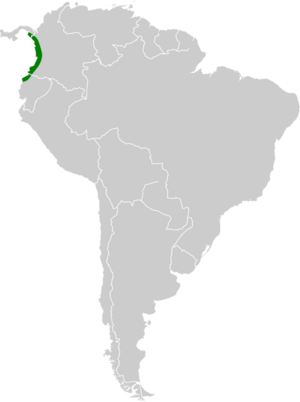Choco broad-nosed bat facts for kids
Quick facts for kids Choco broad-nosed bat |
|
|---|---|
| Conservation status | |
| Scientific classification | |
| Genus: |
Platyrrhinus
|
| Species: |
chocoensis
|
 |
|
| Synonyms | |
|
Vampyrops chocoensis |
|
The Choco broad-nosed bat (Platyrrhinus chocoensis) is a cool type of bat that lives in parts of South and Central America. You can find it in countries like Colombia, Panama, and Ecuador. It lives in the lowlands of the Choco region.
Sadly, this bat is considered vulnerable. This means it needs our help because its home is disappearing. In 2013, a group called Bat Conservation International even put it on a special list of bats needing urgent protection.
Contents
Discovering the Choco Broad-Nosed Bat
Scientists first found this bat in 1984 in Colombia. Its name, chocoensis, comes from the Chocó Department region where it was discovered.
Scientists use different ways to study how bats are related. One way is by looking at their body shapes (called morphology). Another way is by studying their DNA. These studies help scientists understand the bat's family tree.
What Does the Choco Broad-Nosed Bat Look Like?
This bat is a medium-sized bat for its group. Its forearms are about 47 to 51 mm (1.8 to 2.0 in) long. It weighs around 30 g (1.1 oz).
The Choco broad-nosed bat has a single whisker on its upper lip. It also has seven whiskers around its special nose-leaf. It has dark stripes on its face. Its ears have clear folds.
The bat has narrow stripes on its back. Each hair on its back has three different colors. The hairs on its belly have two colors.
What Does the Choco Broad-Nosed Bat Eat?
The Choco broad-nosed bat mainly eats fruit. This means it is a frugivore. But it also helps plants by acting as a pollinator. This means it helps spread pollen from one flower to another.
Scientists believe these bats can have babies throughout the year. Pregnant females have been seen at different times.
Where Does the Choco Broad-Nosed Bat Live?
This bat has been found in two places in the lowlands of southern Panama. It has also been seen in over twenty places in both Colombia and Ecuador.
They live on the side of Colombia and western Ecuador that faces the Pacific Ocean. They prefer lower areas, from about 1 to 1,000 m (3.3 to 3,300 ft) above sea level.
Helping the Choco Broad-Nosed Bat
In 2020, this bat was first listed as endangered. This was because scientists thought its numbers would drop by 50%. Now, it is listed as vulnerable. This means its numbers are expected to drop by about 30%.
The good news is that some of the places where these bats live are protected areas. These include Utría National Natural Park and Los Katíos National Park in Colombia.
However, the bat's home is being changed into farms. Farmers are growing crops like cocoa. Illegal mining in Colombia also destroys the bat's habitat. These activities threaten the Choco broad-nosed bat.


